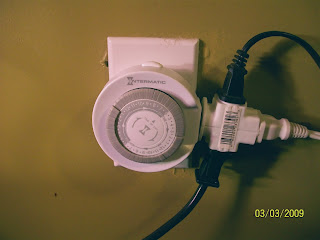The four basics of starting your own seeds are seeds, media, light, and heat. For seeds, I used Seed Savers again because they have an enormous selection of heirloom varieties and they act as a genetic repository and educational resource. In short, I think they're pretty darn cool. Sandhill Preservation is another great choice. The selection at Sandhill is slightly less enormous but I found some more obscure varieties in their catalogue last year when I couldn't find them elsewhere.
Once you've procured the seeds, you'll need a place to put them. Someplace hospitable. So what does a seed consider hospitable? If you go to a garden center you'll find that most of the seed-starting media contain peat moss. If you followed Smallholdings last year, you'll remember that peat moss is a non-renewable resource and that we should keep our paws off it. So why does everyone use it? Because it's very light and easy for seeds to push their way through- and because it's the only thing available in most garden centers. Other options are coir (coconut fiber) and various combinations are compost, soil and vermiculite (a mineral that prevents compaction and improves water retention). I use coir and have found it to work well. Farms tend to make their own blend, which you might want to look into if you have a huge garden but keep in mind that vermiculite is not the waste product of another process, but rather is mined and so is not a the sustainable choice. Coir in the form of individual pods, larger pressed bricks or loose fiber can be found easily online or at a hydroponics supply store. This year I'm trying out individual pods and re-using my plastic trays from last year, which I washed in very hot soapy water to remove fungus spores or harmful bacteria that might be left over from last year. With seeds and media in hand, just follow the instructions on the seed packets. Things that should be started ahead of time usually say "start indoors _ to_ weeks before the last frost". In eastern Mass, that magic date is May 15th, give or take. My approach is to start watching the 10-day forecast the last week of April and if it seems safe, I may take my chances and plant a few things. As for light, a few cheap fluorescent growlights will do the trick if you can get them very close to the seedlings- no more than 18 inches. Ideally, you can set up the whole operation in an area that gets some natural sunlight as well. I put mine on a timer so I don't have to worry about keeping with the cycle.
 Heat can be accomplished in a few ways. Some seeds need to be quite warm to germinate (peppers, for example need about 80 degrees), so don't neglect this part. If money is no object, buy some warming cables or pads from a garden supply house. If your holdings are small, buy a clamp lamp at the hardware store, screw a 100 watt full-spectrum bulb into it and clamp it near enough to your trays to warm the soil to 80 degrees. Plastic covers help keep the temperature of the trays up but beware of mold. Open the lids several time a day and ventilate with a fan if possible. Speaking of fans, adding one to your setup can speed the hardening off process. A light breeze will cause plants to lignify or become woody and strong faster, which will be helpful when they're on their own in the elements. I've updated my system (a term I use loosely) a bit from last year. So here's the new and improved, Plant Nursery 3000
Heat can be accomplished in a few ways. Some seeds need to be quite warm to germinate (peppers, for example need about 80 degrees), so don't neglect this part. If money is no object, buy some warming cables or pads from a garden supply house. If your holdings are small, buy a clamp lamp at the hardware store, screw a 100 watt full-spectrum bulb into it and clamp it near enough to your trays to warm the soil to 80 degrees. Plastic covers help keep the temperature of the trays up but beware of mold. Open the lids several time a day and ventilate with a fan if possible. Speaking of fans, adding one to your setup can speed the hardening off process. A light breeze will cause plants to lignify or become woody and strong faster, which will be helpful when they're on their own in the elements. I've updated my system (a term I use loosely) a bit from last year. So here's the new and improved, Plant Nursery 3000



As you can see, it doesn't take a ton of money, special equipment, or expertise. To keep it all straight, don't forget to label the pods clearly with the name of the plant, the date you started it, and, in case you want to calculate germination rates, the total number of seeds you planted of each variety.Happy spring! Now, get to work.













